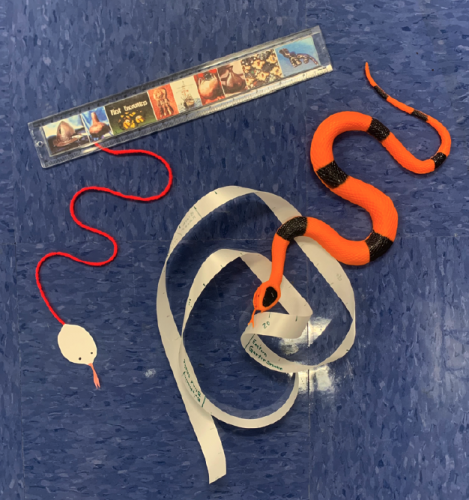Make a cool measuring tool to improve your powers of observation!
String Snake and Survey Instructions
Ages: 5 and up
Time Required: 10-20 minutes
 Materials
Materials
Part 1: Making Your String
- Ruler & roll of light-colored ribbon
- Crayons or markers
Part 2: Using your String
- 5 or more snake shaped items of different sizes (belts, yarn, shoelaces, hoses, or toy snakes)
- Pencil & snake string from Part 1
- Data sheet (see String Snake and Survey Instructions)
Try This!
Step 1: Use your ruler to mark inches on one side of the ribbon. Mark the other side with names and lengths of common snakes in your area. Use different colors markers. Use the Florida snakes ID Guild for size references. (see extension activity if you aren’t sure what snakes are in your area).
Step 2: Have a friend scatter the “fake snakes” outside, some into coils, partially hiding others, hanging in trees, etc.
Step 3: When you first spot a snake, decide how close you can get to it and mark this distance in the first column on your chart. Record the type of each snake in the second column (shoelace, yarn etc.); whether its position was straight, coiled, half-hidden, and so on in the third column; and an estimate of its length in the fourth column.
Step 4: Gather all fake snakes and measure each one with a measuring tape; write these numbers in the final column. Compare your estimated lengths with the actual lengths. Most people
What’s Going On?
Most people overestimate the length of snakes they see because the bigger snakes make for better stories. Scientist can’t catch all the snakes or reptiles they see so they learn to estimate lengths based on your experience: Would you believe an estimate made if someone saw only part of a snake? As you can imagine snakes can come in many different shapes and sizes, the longest snake in the world is the Reticulated Python that can be found in southeast Asia, measuring 6.25 meters (20.5 feet). The smallest snake in the world at least at the moment that this was written is the Barbados Threadsnake, which only measures 10.4 centimeters (4.09 inches).
Extension Activity
Use iNaturalist.org to discover the snakes that have been seen close to where you live or your favorite park! You can do this by: 1) visiting the “explore” section on the website; 2) using the map grid and locating your point of interest; 3) filter results by “reptiles” and look at the species that have been reported nearby! Try to find what’s the smallest species of snake and the largest that you can find in your area, learn if they are venomous or non-venomous and learn about what they like to eat and where they like to live. This information might help you identify a snake if you ever encounter one, but please remember never disturb wildlife, always maintain a safe distance (at least 6 feet or more if it’s a large snake) when you are observing them.